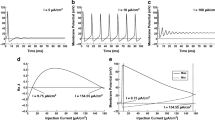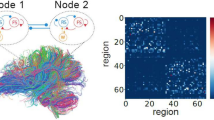Abstract
Bursting is a typical firing behavior intrinsically existing in neurons from many brain regions, which has been thought to have functional roles in neuronal reliable signaling and synaptic plasticity. Meanwhile, many factors have been put forward to participate in the modulation of bursting behavior during the past decades. Here, in this research, the modulation of bursting behaviors was numerically investigated in a two-compartment model of cortical pyramidal neuron using the coupling strength and time delay between compartments as control parameters. By means of computer simulations, we showed that, for larger coupling strengths and smaller delays between the two compartments, a wide range of regular bursting can be observed, while too large coupling strengths and time delays would cause the model neuron to be quiescent. In addition, the dynamical firing range of regular spiking can be also obtained, which has two parts: one part corresponds to small coupling strengths irrespective of the values of time delay, while another part corresponds to larger coupling strengths and delays. These results suggested that coupling strength and internal time delay between the inner compartments possess potential roles in modulating the dynamical bursting behavior of neurons.







Similar content being viewed by others
References
Shuai J, Bikson M, Hahn PJ, Lian J, Durand DM (2003) Ionic mechanisms underlying spontaneous CA1 neuronal firing in Ca2+-free solution. Biophys J 84(3):2099–2111
Shilnikov A, Cymbalyuk G (2005) Transition between tonic spiking and bursting in a neuron model via the blue-sky catastrophe. Phys Rev Lett 94(4):048101
Overton PG, Clark D (1997) Burst firing in midbrain dopaminergic neurons. Brain Res Rev 25(3):312–334
Llinás RR, Steriade M (2006) Bursting of thalamic neurons and states of vigilance. J Neurophysiol 95(6):3297–3308
Bobkov YV, Ache BW (2007) Intrinsically bursting olfactory receptor neurons. J Neurophysiol 97(2):1052–1057
Samengo I, Montemurro MA (2010) Conversion of phase information into a spike-count code by bursting neurons. PLoS ONE 5(3):e9669
Lisman JE (1997) Bursts as a unit of neural information: making unreliable synapses reliable. Trends Neurosci 20(1):38–43
Cunningham MO, Whittington MA, Bibbig A, Roopun A, LeBeau FE, Vogt A, Monyer H, Buhl EH, Traub RD (2004) A role for fast rhythmic bursting neurons in cortical gamma oscillations in vitro. PNAS 101(18):7152–7157
Khosravi-Hashemi N, Fortune ES, Chacron MJ (2011) Coding movement direction by burst firing in electrosensory neurons. J Neurophysiol 106(4):1954–1968
Kepecs A, Wang XJ, Lisman J (2002) Bursting neurons signal input slope. J Neurosci 22(20):9053–9062
Dolev I, Fogel H, Milshtein H, Berdichevsky Y, Lipstein N, Brose N, Gazit N, Slutsky I (2013) Spike bursts increase amyloid-β 40/42 ratio by inducing a presenilin-1 conformational change. Nat Neurosci 16(5):587–595
Hahn PJ, Russo GS, Hashimoto T, Miocinovic S, Xu W, Mclntyre CC, Vitek JL (2008) Pallidal burst activity during therapeutic deep brain stimulation. Exp Neurol 211(1):243–251
Filatov G, Krishnan GP, Rulkov NF, Bazhenov M (2011) Dynamics of epileptiform activity in mouse hippocampal slices. J Biol Phys 37(3):347–360
McCormick DA, Contreras D (2001) On the cellular and network bases of epileptic seizures. Annu Rev Physiol 63:815–846
Wu N, Enomoto A, Tanaka S, Hsiao CF, Nykamp DQ, Izhikevich E, Chandler SH (2005) Persistent sodium currents in mesencephalic v neurons participate in burst generation and control of membrane excitability. J Neurophysiol 93(5):2710–2722
Ivanchenko MV, Osipov GV, Shalfeev VD, Kurths J (2007) Network mechanism for burst generation. Phys Rev Lett 98(10):108101
Medvedev GS, Zhuravytska S (2012) Shaping bursting by electrical coupling and noise. Biol Cybern 106(2):67–88
van Elburg RA, van Ooyen A (2010) Impact of dendritic size and dendritic topology on burst firing in pyramidal cells. PLoS Comput Biol 6(5):e1000781
Schiemann J, Schlaudraff F, Klose V, Bingmer M, Seino S, Magill PJ, Zaghloul KA, Schneider G, Liss B, Roeper J (2012) K-ATP channels in dopamine substantia nigra neurons control bursting and novelty-induced exploration. Nat Neurosci 15(9):1272–1280
Drion G, Bonjean M, Waroux O, Scuvée-Moreau J, Liégeois JF, Sejnowski TJ, Sepulchre R, Seutin V (2010) M-type channels selectively control bursting in rat dopaminergic neurons. Eur J Neurosci 31(5):827–835
Wang L, Liu S, Zhang J, Zeng Y (2012) Burst firing transitions in two-compartment pyramidal neuron induced by the perturbation of membrane capacitance. Neurol Sci 33(3):595–604
Wang L, Liu S, Zhang J, Zeng Y (2012) Temperature-dependent transitions of burst firing patterns in a model pyramidal neuron. Neurophysiology 44(4):265–273
Wang L, Zeng Y (2013) Control of bursting behavior in neurons by autaptic modulation. Neurol Sci 34(11):1974–1977
Franceschetti S, Guatteo E, Panzica F, Sancini G, Wanke E, Avanzini G (1995) Ionic mechanisms underlying burst firing in pyramidal neurons: intracellular study in rat sensorimotor cortex. Brain Res 696(1–2):127–139
Mantegazza M, Franceschetti S, Avanzini G (1998) Anemone toxin (ATX II)-induced increase in persistent sodium current: effects on the firing properties of rat neocortical pyramidal neurones. J Physiol 507(1):105–116
Kepecs A, Wang XJ (2000) Analysis of complex bursting in cortical pyramidal neuron models. Neurocomputing 32–33:181–187
Pinsky PF, Rinzel J (1994) Intrinsic and network rhythmogenesis in a reduced Traub model for CA3 neurons. J Comput Neurosci 1(1–2):39–60
Kamondi A, Acsády L, Wang XJ, Buzsáki G (1998) Theta oscillations in somata and dendrites of hippocampal pyramidal cells in vivo: activity-dependent phase-precession of action potentials. Hippocampus 8(3):244–261
London M, Häusser M (2005) Dendritic computation. Annu Rev Neurosci 28:503–532
Gulledge AT, Kampa BM, Stuart GJ (2005) Synaptic integration in dendritic trees. J Neurobiol 64(1):75–90
Gollo LL, Kinouchi O, Copelli M (2009) Active dendrites enhance neuronal dynamic range. PLoS Comput Biol 5(6):e1000402
Author information
Authors and Affiliations
Corresponding author
Rights and permissions
About this article
Cite this article
Wang, L., Zeng, Y. The role of coupling strength and internal delay between compartments in shaping the bursting behavior of cortical neuron. Neurol Sci 35, 883–889 (2014). https://doi.org/10.1007/s10072-013-1619-y
Received:
Accepted:
Published:
Issue Date:
DOI: https://doi.org/10.1007/s10072-013-1619-y




